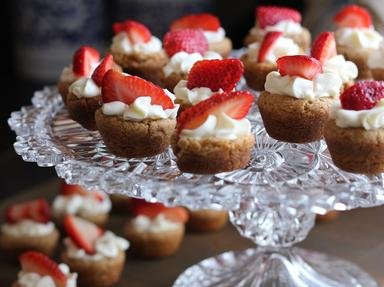Quiz Answer Key and Fun Facts
1. Agar (formally agar-agar) is often used instead of gelatine in recipes. Which of these is NOT a reason why agar might be preferable to gelatine?
2. The Japanese dessert anmitsu is made of cubes of agar jelly served with what two ingredients which give the dish its name?
3. The Japanese sweet yokan is usually made from agar, red bean paste, and sugar, formed into blocks. One version, however, uses white kidney beans instead of red, producing a milky color and a relatively bland flavor. What is commonly used in this type of yokan to add color and flavor?
4. In the Philippines, sago't gulaman samalamig is a popular dessert / drink that is often sold from roadside stands. Of course, since it is featured in this quiz, it contains agar (called gulaman in Filipino). Which of the following is NOT also an ingredient in authentic sago't gulaman samalamig?
5. While we're in the Philippines, we must try the most popular Filipino dessert, made by placing a mixture of fruits, sweetened beans, and agar jelly cubes in a bowl and covering them with shaved ice. Another set of sweet ingredients follows, and evaporated milk is poured over the lot before serving. What is the name of this dessert?
6. The Filipino dessert buko pandan is flavored with pandan (screwpine) and buko (coconut). It goes without saying that gulaman (agar-agar) is included. What other ingredient is always a part of the dish?
7. The Vietnamese dish thach rau cau is made with agar-agar. What is the usual English translation of its name?
8. What is the main flavoring used for the Burmese jellies called kyauk kyaw (pronounced chow chaw)?
9. Southeast Asia is not the only part of the world where agar is used for sweet dishes. In Poland, a popular candy called ptasie mleckzo is made using either gelatine or agar to make a marshmallow-like filling with a chocolate coating. What is the literal English translation of its name?
10. The Russians imported the Polish candy ptasie mleckzo and renamed it ptichye moloko. Then they developed another dessert based on the same culinary concept, and that is what the name now refers to. What type of dessert would you get in Russia if you asked for ptichye moloko?
Source: Author
looney_tunes
This quiz was reviewed by FunTrivia editor
ozzz2002 before going online.
Any errors found in FunTrivia content are routinely corrected through our feedback system.

